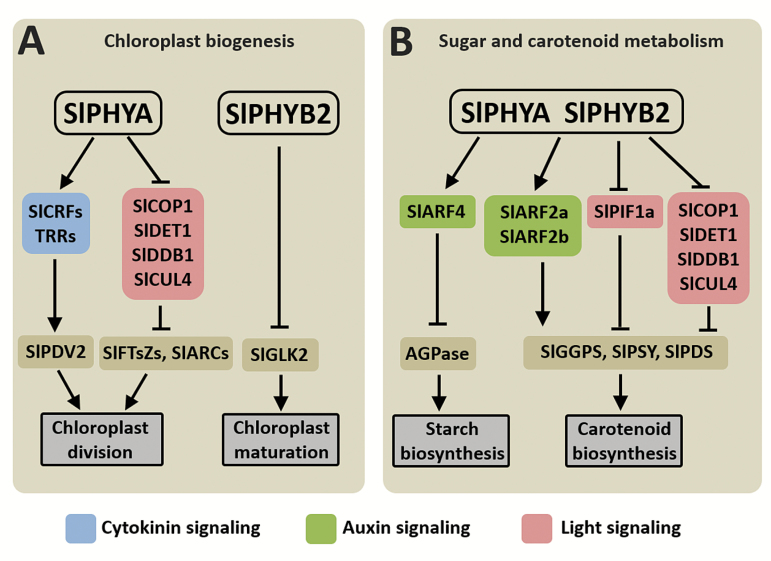Fig. 7.
Proposed model for phytochrome-mediated signaling events controlling chloroplast biogenesis, and sugar and carotenoid metabolism in tomato fruits. (A) SlPHYA- and SlPHYB2-dependent light perception regulate fruit plastid division and maturation, respectively. By promoting key members of the cytokinin signaling-related CRF and TRR gene family, SlPHYA up-regulates SlPDV2, a rate-limiting component of the plastid division machinery. Moreover, the SlPHYA-mediated down-regulation of light-signaling repressors, such as SlCOP1, SlDET1, SlDDB1, and SlCUL4, induces other major components of the chloroplast division machinery, such as SlFTsZs and SlARCs. In contrast, Sl-PHYB2 represses the chloroplast differentiation transcription factor SlGLK2, consequently limiting chloroplast differentiation during early fruit development. (B) Fruit-localized SlPHYA and SlPHYB2 play overlapping roles in repressing and promoting starch and carotenoid biosynthesis, respectively. Both SlPHYA and SlPHYB2 induce SlARF4, a negative regulator of AGPase and starch accumulation in tomato fruits. In contrast, these same photoreceptors promote both SlARF2 paralogues and inhibit all the major genes encoding light-signaling repressor proteins, consequently up-regulating most components of the tomato carotenoid biosynthetic route. Arrows at the ends of lines indicate stimulatory effects, whereas bars indicate inhibitory effects. AGPase, ADP-glucose pyrophosphorylase; ARC, accumulation and replication of chloroplasts; ARF, auxin response factor; COP1, constitutive photomorphogenic 1; CRF, cytokinin response factor; CUL4, cullin 4; DDB1, UV-damaged DNA binding protein 1; DET1, de-etiolated1; FtsZ, filamentous temperature sensitive-Z; GGPS, geranylgeranyl pyrophosphate synthase; GLK2, golden2-like-2; PDS, phytoene desaturase; PDV2, plastid division 2; PIF, phytochrome interacting factor; PSY, phytoene synthase; TRR, tomato response regulator.

